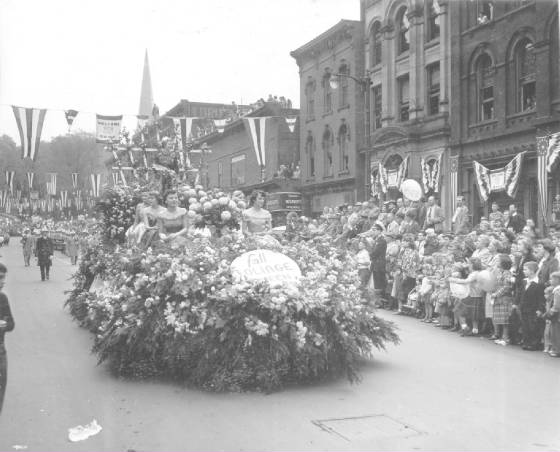|
|
“I used to march in the Fall Foliage Parade when I was a kid. I was in the high school band. It was the longest parade I was in. I always liked that parade. There was something about North Adams. It was very attractive. I liked to look at those grand old buildings on Main Street. I called it the “city of farmers.” It was the attitude. They weren’t city people; they were just country people, real down to earth. There’s always been a special spot in my heart for that place.” -Charles L. Flint, Lenox, Mass.
By the time this column appears, participants in the Fall Foliage Parade will have marched past some new businesses that weren’t around for the 2001 parade: Harpin’s Pastry Plus Café, Color Accents, Everything Art, Milan@55 Main, Inkberry, Edward Jones, and Moulton’s General Store. There will be more soon.
October is here. Up on the mountain behind Mass MoCA, the area of trees called “the arrow” is displaying its early colors. Down below, the upside-down trees are already a deep reddish brown. Mornings start off cool and foggy, and hot coffee at the Bean tastes even better, as warm conversations almost shimmer with humor and optimism. This is the best time of the year.
Autumn is when North Adams gets to dress up in its finest clothes and stroll down the runway. From the foot of Mt. Williams to the Hairpin Turn, nature puts on a fashion show, and visitors come from all over to watch.
This week, civic leaders from Philadelphia, San Antonio, Asheville, Chicago, Seattle and the Bronx will be here, too. They should be duly impressed when they walk down Main Street with John Barrett III, as the mayor shows them how a community can recover and grow under the umbrella of art and culture, and by the sheer pride, determination and hard work of its citizens.
Thanks to city native and filmmaker Nancy Kelly, the Center for Independent Documentary, and a $500,000 grant from the Ford Foundation, North Adams is being studied by other communities that are looking for ways to spark economic and spiritual revitalization. Welcome to the Downside UP Listening Tour.
Thirty years after urban renewal left a wasteland on Main Street, 15 years after Sprague Electric laid off thousands and closed the Marshall Street plant, and six years after a national magazine called the city a “sorry gateway to anywhere,” North Adams is being held up as an example of how to do things right.
The Massachusetts Museum of Contemporary Art has received much of the credit for the city’s recovery, and justifiably so. But when Mass MoCA was only a germinating idea looking for funds, neighborhood leaders in the River Street and Freeman Grove area, and a new agency called Northern Berkshire Health and Human Services Coalition were tackling the daunting task of putting North Adams back together again.
Now called the Northern Berkshire Community Coalition, the agency is 16 years old, and is a powerful force for positive social change in the area. It benefits everyone: the elderly, schoolchildren, new immigrants, and a variety of neighborhood groups. And the United Neighborhood Organization (UNO) that emerged from the River Street/Freeman Grove area is celebrating its twelfth birthday this month. Without their work, North Adams could not have provided the building blocks for Mass MoCA to succeed.
Nor could the community have moved forward without the contributions of artists like Eric Rudd, who founded the Contemporary Artists Center in the Beaver Mill long before MoCA contractors opened their toolboxes for the first time at the Sprague Electric site. And when Eagle Street was just a well-worn curiosity with a gloomy future, Rudd bought and redeveloped the Flatiron Block, shoveled sand at his wildly successful Beach Party, and helped establish a new identity for what has become the focal point for commercial and cultural revival in the city.
The Coalition, UNO, and artists like Rudd share a common philosophy: “Anything is possible.” In the past few years, that philosophy has filtered down to residents who might otherwise have felt that the river had come to their door one too many times. And now with Mass MoCA, and a wave of artists (natives and newcomers) on the scene, our young people are caught up in something that might not have occurred to their parents a generation ago. Like artists, kids are idealists who also believe that “anything is possible.” Today they are surrounded by institutions and role models that can nurture and sustain that belief.
I took a friend on a walking tour of the city last Wednesday. We were standing on the south summit of Hill Side Cemetery where the Blackinton monuments are located. We looked north at the colorful “arrow” overlooking us, and I thought to myself, “We can see over the mountain now.” For the folks on the Downside UP Listening Tour, that is one lesson to take back to their hometowns.
